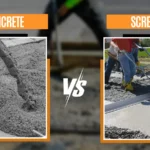Construction would be incomplete without concrete pumping. Its purpose is to simplify, expedite, and streamline the delivery and pouring of concrete. Without these modern marvels, construction workers would need to rely on traditional methods, such as transporting concrete-laden wheelbarrows multiple times to the desired location.
With an impressive output of 1m3 of concrete per minute, they’re much quicker than any other concrete transportation method available. As a result, they’re an ideal choice when time is of the essence.
Types Of Concrete Pumps That You Might Require
One of the most important tools in the industry’s material is the concrete pump truck, which really puts efficiency in transportation and pouring. These machines work by using a hydraulic system to pump concrete through a pipeline to the location you want, eliminating the need for manual labour and reducing the risk of any waste.
There are two main types that are commonly used: ground pumps and boom pumps.
Ground line pump
Line pumps are an excellent solution for projects that require the fast and smooth delivery of concrete to the location of your choice. These are hydraulic pumps mounted on trucks designed to transport concrete at a fast rate of 1m3 per minute. Their speed and efficiency make them ideal for large constructions, where a significant amount of concrete needs to be delivered within a short time frame.
Here are some features of concrete line pumps:
- Standard 50 meters of line: Ground line pumps come equipped with 50 meters of the line as standard, allowing for the transportation of concrete over a considerable distance.
- Pumping distance: These can pump over 150 meters along the ground, making them fantastic for large-scale construction projects.
- Flexibility: The availability of both steel and flexi pipes allows for greater flexibility and makes it easier to pour concrete in hard-to-reach areas, including round corners.
- Efficiency: They are quick, productive, and ideal for time-sensitive projects.
- Easy to hire: Ground line pumps are available for hire without concrete on a 4-5 hour period, and drivers can set up the line and pack it back down once the job is finished. Learn more about Renting a Concrete Pump.
Boom pump
Sometimes, the location may be in an area that is a little troublesome, the upper floors of a building or a construction site surrounded by obstacles. In such cases, the traditional ground line pump may not be adequate to deliver concrete, and a boom pump is a perfect solution.
Concrete boom pumps use hydraulic arms to extend up and over buildings, walls, and other things, making it possible to reach even the most challenging locations. These hydraulic arms are typically made of several interconnected steel sections. What this does is help you manoeuvre them to the required position. This flexibility means that boom pumps can be positioned at various angles and can easily navigate around the construction site.
The following are some of the main features of boom pumps:
- Hydraulic arm: This is the defining feature of boom pumps, allowing them to reach up to 72 meters.
- Speed: Boom pumps are capable of transporting and concrete pumping at around 1m3 per minute. This is ideal for large projects that require a significant amount of concrete.
- Various sizes: They come in various different sizes ranging from 20 meters to 72 meters.
- Versatility: These pumps are suitable for both domestic and commercial jobs alike.
- Skilled operators: A highly skilled boom operator is required to operate a boom pump so that the pump is used safely.
How To Prepare For Concrete Pumping
Site Accessibility and Clearance
Getting a concrete pumping service requires preparation to guarantee that the site is clear and accessible for the trucks and pumps. Although they are designed to reach difficult places, it’s paramount to enhance their accessibility by vacating the site where possible.
Planning for Space Limitations
If the site has limited space for the trucks, plan accordingly. Perhaps you have a narrow driveway, or your property is situated far back from the road. In such situations, inform the pumping service provider in advance, so they can adjust their approach.
Pre-Job Consultation
Before dispatching a truck, a specialist from the pumping service provider will contact you to discuss your specific requirements. This will help determine the appropriate pump for your need, making sure that the job is completed perfectly and on time.
The Wrap Up
The ability to pump concrete at these rates represents a significant advancement over traditional methods. Saving valuable time and reducing physical labour on construction sites of all sizes are just a few advantages of the facility.
However, successful concrete pumping operations depend heavily on proper preparation. Clear site access, advance planning for space limitations, and effective communication with your pumping service provider ensure smooth execution on the day of the pour. Taking time to assess potential obstacles and discuss specific requirements with specialists will significantly reduce the risk of delays or complications.
At Pro Mix Concrete London, we value our customers and are committed to providing you with the information you need to make a proper decision about what exactly you will need. Perhaps you’re wondering about the specific benefits of using a concrete pump, or you may be curious about the different types of pumps available and which one would be best for your project. No matter what your question is, we’re here to help.
Frequently Asked Questions
Concrete pumping is a method of transferring liquid concrete to specific locations using specialised equipment. It involves using hydraulic systems to move concrete through pipelines or hoses directly to where it’s needed on construction sites.
A concrete pump works by using powerful hydraulic systems to push concrete through pipelines. The process begins when ready-mix trucks discharge concrete into the pump’s hopper. Inside the pump, hydraulic pistons create pressure that forces the concrete through connecting pipes or a boom system. Alternating cylinders work in sequence to maintain continuous flow, allowing the concrete to travel significant distances both horizontally and vertically to reach precise placement locations.
While concrete pumping offers advantages for nearly all concrete placements, it provides particular benefits for:
- High-rise buildings requiring vertical concrete transport
- Projects with limited access for ready-mix trucks
- Large foundation pours requiring continuous concrete placement
- Locations with obstacles between the concrete supply and placement area
- Sites where speed of placement is critical
Not all concrete mixes are suitable for pumping. Pumpable mixes typically require:
- Proper aggregate gradation (generally smaller maximum aggregate size)
- Sufficient cement content and fine materials
- Appropriate slump and flowability
- Special additives for challenging applications
Specialised high-strength, lightweight, or fiber-reinforced mixes may require adjustments for successful pumping.
Author
- Dennis Broderick
- Dennis Broderick is the founder and owner of Pro-Mix Concrete Company, a trusted name in ready-mix concrete solutions across the UK. With over 20 years of hands-on experience in the construction and concrete industry, Dennis brings unmatched expertise, practical insights, and a commitment to quality on every project - from residential driveways to large-scale commercial developments.
Latest entries
BlogJuly 15, 2025Why Same-Day Concrete Delivery is Vital for Small Builders in London?
BlogJuly 10, 2025Concrete vs. Screed: Which is Best for Your Project?
BlogJuly 5, 20255 Mistakes to Avoid When Ordering Ready Mix Concrete in London
BlogJune 27, 2025How Same-Day Concrete Delivery Works in the UK?




